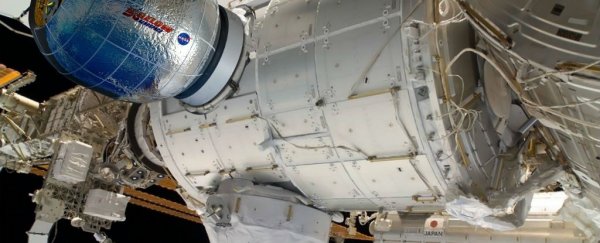The International Space Station (ISS) is about to have a giant, inflatable 'space house' attached to its exterior, which will remain for two years before being blasted out into space.
Set to be launched next week aboard SpaceX's Falcon 9 rocket, the so-called Bigelow Expandable Activity Module (BEAM) can expand to almost twice its original size at the push of a button, giving ISS astronauts an additional 3.6-metre (12-feet) room to test out as a potential lunar or Martian home.
"As we venture deeper into space on the path to Mars, habitats that allow for long-duration stays in space will be a critical capability," said William Gerstenmaier, associate administrator for human exploration and operations at NASA.
"Using the [ISS's] resources, we'll learn how humans can work effectively with this technology in space, as we continue to advance our understanding in all aspects for long-duration spaceflight aboard the orbiting laboratory."
After being attached to the Tranquility Node on the ISS's rear port using the ISS's robotic Canadarm2, the BEAM will be inflated over a 45-minute period.
Astronauts will then visit it over the course of a two-year period to conduct a series of tests that will measure its radiation protection, temperature variations, response to micrometeroids and orbital debris, and other factors that could make or break its potential as the outer space home of the future.
"It's certainly a possibility," NASA's BEAM project manager, Rajib Dasgupta, told Gizmodo. "Success on the ISS would go a long way towards proving expandables [can work]."
 NASA
NASA
Inflatable habitats are, in theory, a really promising candidate for what we could be living in once we establish a colony on the Moon, or one day even Mars.
They're light and compact enough to be transported on a rocket, and preliminary tests have shown that they can offer a degree of protection from solar and cosmic radiation, space debris, atomic oxygen, ultraviolet radiation, and other elements of the space environment. Just how much protection is what the ISS astronauts will now have to figure out.
Inflatable capsules could also be used to house supplies on the Moon or Mars before potential inhabitants even arrive, as NASA explains:
"Before sending the first astronauts to the Red Planet, several rockets filled with cargo and supplies will be deployed to await the crews' arrival. Expandable modules, which are lower-mass and lower-volume systems than metal habitats, can increase the efficiency of cargo shipments, possibly reducing the number of launches needed and overall mission costs."
We can't wait to see how everything goes. If we really do want to colonise the Moon by 2022, as experts have estimated we can, experiments like this are crucial.
You can watch an artist's conception of the installation process below:
